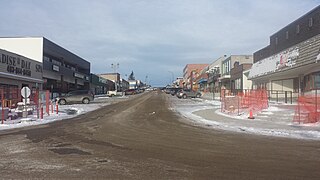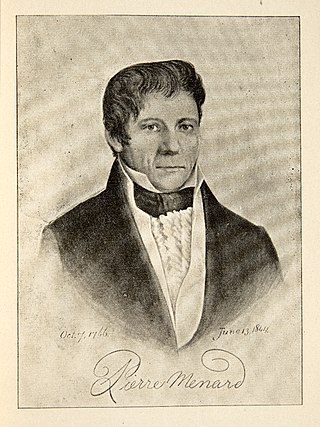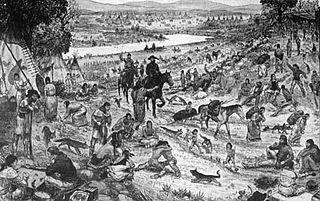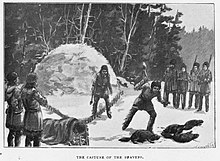
Montana is a state in the Mountain West division of the Western United States. It is bordered by Idaho to the west, North Dakota and South Dakota to the east, Wyoming to the south, and the Canadian provinces of Alberta, British Columbia, and Saskatchewan to the north. It is the fourth-largest state by area, the eighth-least populous state, and the third-least densely populated state. Its state capital is Helena, while the largest city is Billings. The western half of Montana contains numerous mountain ranges, while the eastern half is characterized by western prairie terrain and badlands, with smaller mountain ranges found throughout the state. The state has a reputation for a libertarian bent in popular opinion and policy.
The Marias Massacre was a massacre of Piegan Blackfeet Native peoples which was committed by the United States Army as part of the Indian Wars. The massacre occurred on January 23, 1870, in Montana Territory. Approximately 200 Native people were killed, most of whom were women, children, and older men.

A mountain man is an explorer who lives in the wilderness and makes their living from hunting and trapping. Mountain men were most common in the North American Rocky Mountains from about 1810 through to the 1880s. They were instrumental in opening up the various emigrant trails allowing Americans in the east to settle the new territories of the far west by organized wagon trains traveling over roads explored and in many cases, physically improved by the mountain men and the big fur companies originally to serve the mule train-based inland fur trade.

The American Fur Company (AFC) was founded in 1808, by John Jacob Astor, a German immigrant to the United States. During the 18th century, furs had become a major commodity in Europe, and North America became a major supplier. Several British companies, most notably the North West Company and the Hudson's Bay Company, were eventual competitors against Astor and capitalized on the lucrative trade in furs. Astor capitalized on anti-British sentiments and his commercial strategies to become one of the first trusts in American business and a major competitor to the British commercial dominance in North American fur trade. Expanding into many former British fur-trapping regions and trade routes, the company grew to monopolize the fur trade in the United States by 1830, and became one of the largest and wealthiest businesses in the country.

Rocky Mountain House is a town in west-central Alberta, Canada. It is approximately 77 km (48 mi) west of Red Deer at the confluence of the Clearwater and North Saskatchewan Rivers, and at the crossroads of Highway 22 and Highway 11. The surrounding Clearwater County's administration office is located in Rocky Mountain House.

Pierre Menard was a fur trader and U.S. political figure. Pierre Menard was born at St. Antoine-sur-Richelieu, near Montreal, Canada, third in a family of ten children. His father was Jean Baptiste Ménard, a French soldier in the regiment of Guyenne.
The enterprise that eventually came to be known as the Rocky Mountain Fur Company was established in St. Louis, Missouri, in 1822 by William Henry Ashley and Andrew Henry. Among the original employees, known as "Ashley's Hundred," were Jedediah Smith, who went on to take a leading role in the company's operations, and Jim Bridger, who was among those who bought out Smith and his partners in 1830. It was Bridger and his partners who gave the enterprise the name "Rocky Mountain Fur Company."
This is a broad outline history of the state of Montana in the United States.

Kenneth McKenzie was nicknamed the "King of the Missouri", for as a fur trader for American Fur Company in the upper Missouri River valley, he controlled a territory larger than most European nations.

Thomas Fitzpatrick was an Irish-American fur trader, Indian agent, and mountain man. He trapped for the Rocky Mountain Fur Company and the American Fur Company. He was among the first white men to discover South Pass, Wyoming. In 1831, he found and took-in a lost Arapaho boy, Friday, who he had schooled in St. Louis, Missouri; Friday became a noted interpreter and peacemaker and leader of a band of Northern Arapaho.

Pierre's Hole is a shallow valley in the western United States in eastern Idaho, just west of the Teton Range in Wyoming. At an elevation over 6,000 feet (1,830 m) above sea level, it collects the headwaters of the Teton River, and was a strategic center of the fur trade of the northern Rocky Mountains. The nearby Jackson's Hole area in Wyoming is on the opposite side of the Tetons.
Fort Raymond or alternatively Manuel's Fort or Fort Manuel, was an outpost established by fur trader Manuel Lisa and was named after his son. The post was located at the confluence of the Bighorn and the Yellowstone Rivers. Upon its foundation it was the first trading post maintained by European descendants in the modern state of Montana. It would be the first of several posts by Lisa over his time in the developing regional fur trade. Among those hired by Lisa for the expedition were several members of the Corps of Discovery at Fort Raymond, notably George Drouillard, John Colter and Peter M. Weiser, who were stationed at Fort Raymond.
Fort Shaw was a United States Army fort located on the Sun River 24 miles west of Great Falls, Montana, in the United States. It was founded on June 30, 1867, and abandoned by the Army in July 1891. It later served as a school for Native American children from 1892 to 1910. Portions of the fort survive today as a small museum. The fort lent its name to the community of Fort Shaw, Montana, which grew up around it.

The Rocky Mountain Rendezvous was an annual rendezvous, held between 1825 and 1840 at various locations, organized by a fur trading company at which trappers and mountain men sold their furs and hides and replenished their supplies. The fur companies assembled teamster-driven mule trains which carried whiskey and supplies to a pre-announced location each spring-summer and set up a trading fair. At the end of the rendezvous, the teamsters packed the furs out, either to Fort Vancouver in the Pacific Northwest for the British companies or to one of the northern Missouri River ports such as St. Joseph, Missouri, for American companies. Early explorer and trader Jacques La Ramee organized a group of independent free trappers to the first ever gathering as early as 1815 at the junction of the North Platte and Laramie Rivers after befriending numerous native American tribes.
The Missouri Fur Company was one of the earliest fur trading companies in St. Louis, Missouri. Dissolved and reorganized several times, it operated under various names from 1809 until its final dissolution in 1830. It was created by a group of fur traders and merchants from St. Louis and Kaskaskia, Illinois, including Manuel Lisa and members of the Chouteau family. Its expeditions explored the upper Missouri River and traded with a variety of Native American tribes, and it acted as the prototype for fur trading companies along the Missouri River until the 1820s.
This is a timeline of pre-statehood Montana history comprising substantial events in the history of the area that would become the State of Montana prior to November 8, 1889. This area existed as Montana Territory from May 28, 1864, until November 8, 1889, when it was admitted to the Union as the State of Montana.

Charles Larpenteur, born 1803, died 1872, was an American fur trader, whose memoir and diary frequently have been used as a source to fur trade history.
The Cracon du Nez occasionally also misspelled as the Crocon du Nez, is a sharp sided ridge that divides the Teton River and the Missouri River in Chouteau County, Montana, at a point where the increasing erosion at a large bend of the Missouri River has caused the two rivers to be a mere third of a mile apart. The Cracon du Nez ridge is an example of Missouri River stream bank erosion developing toward a future "stream capture" of the Teton River flow. A trail runs along the top of the ridge, where in 1865 Little Dog, a chief of the Piegan Blackfoot tribe was ambushed and killed by rebellious and jealous warriors from his own Piegan band. An abandoned railroad tunnel runs under the ridge, part of the former Montana Central Railway branch line of the Great Northern railroad running from Havre to Fort Benton, Great Falls, Helena and Butte. U.S. Highway 87 passes by the ridge and allows the traveler to see the Cracon du Nez. The name is derived from the French and means bridge of the nose, and was probably given by the French boatmen who comprised keelboat crews in the fur trade in the upper Missouri River in Montana during the early decades of the 1800s.
Henry Fraeb, also called Frapp, was a mountain man, fur trader, and trade post operator of the American West, operating in the present-day states of Colorado, Wyoming, and Montana.

Alexander Culbertson (1809–1879), was an American fur trader who founded Fort Benton, Montana, and was a special government agent who played an important role in the negotiations leading to the 1851 treaty of Fort Laramie. Later, Culbertson and his wife Natawista Iksina negotiated with the Blackfoot Confederacy to let the northern Pacific railroad survey of 1853 continue unharmed.















